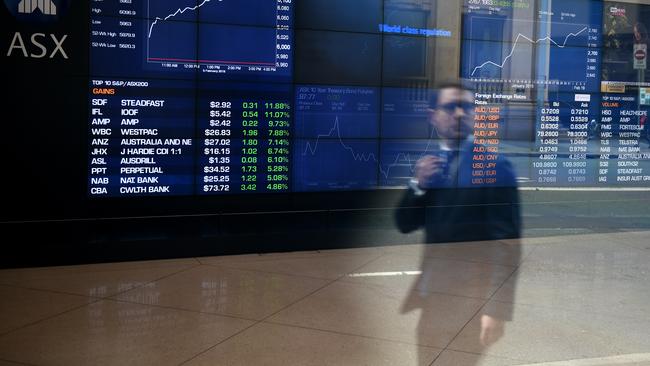How to spend it: Fifty investment ideas for the new year
Whatever your investment interests, you’ll find prospects worth considering here.

The Australian’s wealth editor, James Kirby, and wealth columnists James Gerrard, Will Hamilton and Elizabeth Moran predict the key themes for investors in the next 12 months.
James Kirby
Diversify from our risky sharemarket
In 2019, the economy grew by around 2 per cent, while the sharemarket rose by almost 20 per cent in the 12 months to Christmas. The lift came from falling interest rates not rising company profits. In 2020, spread your risk well beyond the local market.
Understand exchange traded funds
This is the fastest growing sector of our investment market. ETFs are index funds that are listed on the sharemarket. Traditionally, index funds took a basket of stocks such as the S&P/ASX 200 or the S&P 500 and mirrored those stocks in perfect proportion.
Many funds are still based on this model, but other ETFs are based on indices fund managers construct themselves. Or they may be constructed using a formula such as “market weighting” which is not the same as mirroring the index. In other words, ETFs can now be passive or active: know the difference.
Get a grip on the IT and healthcare sectors
Our sharemarket is no longer about industrials, miners and banks. Tech and healthcare stocks now dominate growth stocks and we are not just talking small caps — half of the top 10 best performing ASX 200 stocks last year came from either tech or healthcare: Avita, Polynovo, EML Payments, Nanosonics and Pro Medicus.

Yes, banks, miners and supermarkets take out the bulk of the market’s capitalisation but tech and healthcare are here to stay.
Don’t believe listed securities are alternatives
We know shares are in the late stage of a bull market. No wonder investors are looking for “non-correlated” assets which won’t fall if the market crashes. Cash, gold and holding individual bonds until maturity provide non-correlated alternatives. Anything listed on the ASX — including credit funds — is, by definition, correlated to the ASX. To put that another way, the chances are if the market nosedives, anything listed will very likely fall in tandem, whatever your commission-driven stockbroker might tell you.
Consider gearing
As investors we seem to have no problem gearing when it comes to property — that is borrowing to try and enhance our investment returns. Yet there is a very strong resistance to doing so when it comes to investing elsewhere. With low growth and rock-bottom interest rates, borrowers who finance investments returning more than, say, 4 per cent, are winners. Our dividend yield across the ASX is 4.4 per cent, infrastructure funds return more than 6 per cent. If you accept we are facing soft growth and low interest rates for the medium term, borrowing to enhance returns will often make sense.
-
James Gerrard
Explore first registered loan investments
With bank interest rates on cash and term deposits at record lows, the fixed interest alternative loan investment sector boomed in 2019 as investors sought good yields. This theme is likely to continue into 2020, however investors must have knowledge and respect for what their money is being exposed to: mortgage providers can differ greatly in terms of risk and security.
Consider a property market like no other — Badgerys Creek airport
The NSW government has a masterplan to turn Badgerys and surrounding suburbs into Sydney’s third hub, badging the region an aerotropolis. With the airport construction underway and billions committed to build and infrastructure costs, the airport is scheduled to complete in 2026.
As such, there is an opportunity for savvy investors to purchase what is currently unzoned farmland and other property in the areas surrounding the airport which have been slated to be either low to medium density residential or industrial areas by the government.
Hold infrastructure assets
With sharemarkets raging throughout 2019, investors would be wise to review the defensive qualities of their portfolios and make sure they have investments that would cushion any falls on equity. Infrastructure assets, although having correlated returns to sharemarkets, have what’s known as a low beta. In other words, if markets fell by 10 per cent, one would expect an infrastructure investment to fall by 3 to 4 per cent.
Within the infrastructure asset class there are many types of assets, from toll roads, airports, water pipes and satellite towers to name a few. The more essential the infrastructure, the more resilient it should be in an economic downturn.

Allocate some gold
Similar to infrastructure, gold has been added to portfolios in 2019 for its defensive qualities as investors seek investments that work in the opposite direction of sharemarkets as they get higher and higher. With the global outlook still uncertain, the US elections looming and China trade wars, buying a physical allocation to gold or an exposure via a gold stock or exchange traded fund is another string in the bow for a defensive investor in 2020.
Respect cash
Warren Buffett’s Berkshire Hathaway is sitting on $US128bn ($184bn) in cash as he awaits better investment conditions and opportunities. Individual investors would be wise to take note of this and think about whether they should keep some powder dry in cash and look to invest if there is a correction on markets.
Although returns on cash are barely keeping up with inflation at best, if there were to be a pullback in sharemarkets, every investor would much rather a positive 2 per cent than a negative 10 per cent return for the year.
James Gerrard is a financial adviser at www.financialadviser.com.au
-
Will Hamilton
Determine your risk appetite
How much risk can you tolerate? Sophisticated investors typically ask this question in the light of their financial capacity — in other words, what they can sensibly achieve given their financial and life settings.
So, if you haven’t done it yet, take the time to determine your risk appetite as that is what should guide your investment strategy. From this flows the allocations you make to each asset class at the level of risk appropriate for you. This is a vital activity for an investor.
Consider going overweight international equities.
The Australian equity market powered ahead in 2019 with the ASX 200 up almost 20 per cent, outperforming many international markets.
Based on valuations, I don’t believe this trend will continue into 2020. The local market is trading at approximately 1.2 times the levels indicated by the Morgan Stanley Capital International index. That’s why I suggest being overweight international equities.
Take a long-term position in emerging markets equities
Despite all the China bears, the MSCI Emerging Markets index is up around 16 per cent at the end of the year on a rolling 12 months basis. China makes up just over 34 per cent of the index.
Investors should consider that equities are about investing for growth. The EM basket constitutes 70 per cent of projected world growth over the next 20 years.
Be open to a manageable exposure to high quality illiquid assets
The Future Fund, along with many other industry funds, holds high levels of illiquid investments. In many cases, the exposure is greater than 30 per cent. There is no doubt this approach has had a positive effect on fund returns.

Illiquidity means there may be difficulty in buying or selling the asset quickly. Illiquid assets might include direct property, private equity, infrastructure, and diversified credit.
I have been a strong proponent of illiquid investments for the right clients. They are for those investors who both understand what they are investing in, and who also have a tolerance for their illiquid trading nature.
In searching for yield, understand what you are investing in
The chase for yield is drawing investors to many products and asset classes with which they are unfamiliar. A vital point here is to ensure you understand what it is you are putting your money into. That means seeking help to understand the range of asset classes and the underlying risks.
Keep to the rules: No.1 don’t invest in what you don’t know. No.2 if it sounds too good to be true it probably is. No.3 assess an investment by considering return of capital as well as return on capital. Rule No.4 follow rules 1, 2 and 3.
Will Hamilton is managing partner of Hamilton Wealth Partners will.hamilton@hamiltonwealth.com.au
-
Elizabeth Moran
Try government bonds
Fixed rate, low risk government bonds outperform when interest rates decline and 2019 was a stellar year with three cash rate cuts prompting returns sometimes in the order of 10 per cent. If you expect further cash rate cuts in 2020, then there is still an opportunity for these assets to outperform.
Term deposits remain reliable fixed investments
It is always worth keeping an allocation to cash even if returns are negligible. Some advisers suggest three years of living expenses, but that is too much in this low interest rate environment. High cash holdings in term deposits will put pressure on the rest of your portfolio to earn even higher returns. And therein lies the dilemma only you can solve — finding a balance between risk and reward.
Subordinated bank bonds
Offset some of the risk of your bank shares declining in price by investing in floating rate subordinated bank bonds. These low risk, investment grade securities have much certainty. Unfortunately, they are predominantly issued in the over-the-counter market and not on any exchange. So, you’ll need to contact a fixed income broker to invest.
Test appetite for high yield bonds
Virgin Australia’s successful listed high yield bond in 2019 has seen others come to the market, including high yield ETFs. It’s exciting to see Australian investors realising the potential benefits. But, be aware, high yield means high risk, which includes loss, volatility and illiquidity. Do keep in mind these bonds do not provide the protection of investment grade bonds and act more like the company’s shares.
Invest in your greatest asset — you
It’s OK to indulge and spend some of your money on you. Learn a new skill that can make you a more rounded investor, even book those tickets to that exotic location and create a life-long family memory. Squirrelling it away for a rainy day or the kids and grandkids is fine, but enjoy it along the way
Elizabeth Moran is a fixed interest specialist. elizabeth@moranconsults.com
-
Tim Boreham
Comeback kids?
Westpac (WBC)
Is banking’s basket case of 2019 worth a punt?
Post the money-laundering debacle, plenty of investors would say no. But as with Commonwealth Bank and its Austrac breaches, arguably the sell-off has been overdone.
Broker Morgans notes that at 10.6 per cent, the bank’s tier-one capital ratio is well above that required by the regulator.
Along with sound credit quality, this should support Westpac’s dividends long after the last executive head has been brought out on a stick.
Morgans assumes “no more than” $2bn of civil penalties.
Whitehaven Coal (WHC)
The leading pure-play coal miner has been hit by negative sentiment towards the sector, as well as a production downgrade early last month.
The revision resulted from water shortages at its Maules Creek open-cut mine, which has created dust and haze issues.
Whitehaven shares lost a third of their value in 2019.
Broker Baillieu Holst reckons the shares are worth $3.90, citing “robust” cash. The firm expects a 10.3c-a-share dividend, despite forecasting a 75 per cent earnings decline to $140m.
A2 Milk (A2M)
Sudden CEO departures are always unsettling and it was no exception at A2 after Jayne Hrdlicka resigned after only 18 months at the helm.
Hrdlicka’s exit reportedly resulted from ongoing boardroom tension about the pace of change she was driving. Whatever the case, the China-focused A2 has performed solidly, with management reiterating first-half revenue and profit expectations.
Banking and fintech
FlexiGroup (FXL)
Amid the hype about the $7.7bn market cap Afterpay, investors forgot that FlexiGroup has offered ‘buy now pay later’ (BNPL) consumer financing for more than two decades.
The trouble is, FlexiGroup’s BNPL business covered two confusing products and had not been promoted. This year the company introduced a single product — Humm — and made more noise about its existence.
With a 17 per cent share of the local BNPL market, FlexiGroup is ascribed a relatively meagre $785m market valuation.
Identitii (ID8)
If financial institutions ever need reminding about the importance of good paperwork with overseas client transactions, Westpac’s money-laundering debacle dramatically highlights the dangers.
Backed by foundation client HSBC, Identitii has developed a blockchain-based platform to provide relevant information along with the remittance, such as who the payment is from and what it is for.
According to Identitii chief Nick Armstrong, collecting missing information to support a transaction costs the banks $US48bn a year.
Cashwerkz (CWZ)
Cashwerkz enables depositors to choose the best term deposit from a panel of financial institutions without undergoing burdensome identity tests.
The group facilitated $1.02bn of transactions in the 2018-19 year — up from $324m previously — with its panel growing from 19 approved deposit institutions (ADIs) to 49.
Moreover, it chalked up $1m of deposit revenue, in effect a commission from the ADIs receiving the business.
Cashwerkz needs to build a scalable business, but in a low-rate world its offering is certainly relevant.
Kina Securities (KSL)
The PNG-based bank and wealth manager might operate in a less than robust economy, but its capital adequacy levels put Australian banks to shame.
In September, Kina acquired ANZ’s PNG retail and small business operations for about $10m.
Broker Morgans forecasts $190m of revenue and a $57m net profit in the 2019 calendar year, rising to $268m of turnover and an $82m profit in 2020.
The stock yields 8.6 per cent, but with no franking credits.
Golden ideas
Northern Star (NST)
In buying a half share of the Kalgoorlie Super Pit for $1.14bn, the leading gold miner joins the ranks of the major producers, and comes on to the radar of international investors.
On another lustrous note, management has confirmed that the turnaround plans for its acquired Pogo mine in Alaska are on target.
Northern Star shares have retreated about 30 per cent from their record high in late July.
Kalamazoo Resources (KZR)
Low-market-cap gold explorers offer the potential for leveraged returns regardless of the near-term gold price. But they need to make discoveries that count.
Victorian gold explorers are tipped to have a big 2020, with the excitement centred on the historic Bendigo gold fields and ASX-listed Canadian giant Kirkland Lake’s world class Fosterville mine.
Separately, Catalyst Metals (CYL) has not reported a gold resource yet, but has the honour of being backed by Australia’s richest woman, Gina Rinehart.
Partnering Catalyst at its Tandarra project, Navarre Minerals (NML) is tipped as one to watch, with broker Hartleys valuing the stock at a 50 per cent premium to its current price. But arguably the Victorian gold stock offering the best upside is Kalamazoo, which has started an exploration program at the Castlemaine goldfield.
Coppertunities
OZ Minerals (OZL)
While the US-China trade war has kept the lid on prices for base metals including copper, explorers for the red metal have created investor interest.

Alkane Resources (ALK) and Stavely Minerals (SVY) have both run hard in response to exciting results at their respective projects in NSW and Victoria.
But for those who prefer a “here and now” copper exposure, sector stalwart OZ Minerals is hard to go past as it commissions its Carrapateena copper-gold mine in South Australia’s outback.
Bougainville Copper (BOC)
This one is a raw punt on the island’s recent overwhelming independence vote forging a restart of the giant Panguna copper and gold mine.
Bougainville Copper has been a zombie stock since the island’s protracted civil war halted operations at Panguna in 1989. Since Rio Tinto divested its majority holding in 2016, Bougainville Copper has been controlled by the PNG and autonomous local authorities.
Panguna has an estimated untapped resource of $60bn.
Drugs and devices
Memphasys (MEM)
Given the poor success rate of IVF procedures, patients need all the help they can get and one way is to ensure the best-quality sperm is used in the first place.
Memphasys is developing a sperm separation device called Felix, which uses electrical charging techniques to isolate the best “swimmers”.
Felix is being tested by listed fertility group Monash IVF. It has also been refinanced and overhauled.
Pharmaxis (PXS)
The respiratory drug developer had a late-year stumble after its partner Boehringer Ingelheim pulled out of funding its clinical program for fatty liver disease.
However, the German drug giant is still supporting the company’s diabetic retinopathy program, while Pharmaxis has separate programs for other diseases including idiopathic pulmonary fibrosis, myelofibrosis and diabetic retinopathy. Pharmaxis also has an approved drug for cystic fibrosis called Bronchitol.
Road to prosperity
AP Eagers (APE)
The car dealership group’s takeover of its listed rival Automotive Holdings comes at a torrid time for the industry, with tumbling new-car sales and a clampdown on lucrative insurance products.
The merger provides AP Eagers with the scale to cope with the temporary headwinds, as well as the longer-term challenge of electric and autonomous vehicles.
The union has generated $13.5m of synergy savings, with an estimated $16.5m more to come in the next 12 months.
Bapcor (BAP)
The car industry pessimism has also affected the valuation of Bapcor, which owns the Burson and Autobarn outlets and provides same-day delivery of car parts to mechanics and car retailers.
Bapcor generated a 5 per cent lift in profit to $94m this year and management has guided to “at least mid-single-digit” profit growth in the current year.
Flexible workspace
Servcorp (SRV)
Servcorp has been providing flexible office space since 1978, long before “collaborative co-working zones” became the inner-urban catchcry.
Servcorp shares have more than halved over the past three years because of what founder and CEO Alf Moufarrige dubs the “uncommercial behaviour” of the co-working upstarts.
With a presence in 23 countries, Servcorp has been investing in converting serviced office space to the more casual co-working arrangements.
Fake meat
Jatenergy (JAT)
To committed carnivores, fake meat is fake news but the strong debut of the Nasdaq-listed Beyond Meat shows the concept is gaining traction with investors and consumers.
A Chinese-oriented supplier of goods such as milk powder, Jatenergy is entering the meat-free game via a joint venture arrangement. Its first products will be distributed via a large Shanghai intermediary.
The low-key Jatenergy turned over $66m last year and has cash of about $16m.
Next big thing in tech?
Beam Communications (BCC)
Beam is the only ASX-listed satellite equipment manufacturer, boasting Telstra and the world’s biggest satellite operator as clients.

The group is profitable and growth should be driven by the recent launch of Zoleo, the world’s first satellite device aimed at mainstream consumers.
Titomic (TTT)
Using advanced digital techniques, Titomic produces titanium and metal products faster, more efficiently and cheaper than traditional manufacturers, helping ensure Australia maximises the potential of its mineral resources.
Titomic shares have risen almost fivefold since listing in September 2017
MGM Wireless (MWR)
MGM has struck paydirt with its Spacetalk device: a smartphone, watch and GPS for children aged five to 12.
In November the company said it had sold 12,800 Spacetalks in the first 21 weeks of the first half of the year, compared with 11,000 for the entire first half of 2018-19. Christmas sales were yet to come.
A recent deal with Sky UK accesses a market three times the size of Australia’s.
Cybersecurity
BetaShares HACK ETF
With online scams and data breaches proliferating, cybersecurity is emerging as one of the true secular growth themes.
Dozens of listed stocks now play in the sector, but why try to pick a winner? Aptly bearing the ASX code HACK, the BetaShares Global Cybersecurity ETF is the only ETF in Australia that provides one-stop access to global cybersecurity companies including Symantec, CyberArk and Cisco.
Listed investment companies
Global Masters Fund (GFL)
The listed investment company’s reason for being is to provide Australian investors with a fractional exposure to the US-listed Berkshire Hathaway, the legendary Warren Buffett’s investment vehicle. Berkshire Hathaway shares change hands for more than $US330,000 each.
Global Masters is trading well below its pre-tax net assets per share valuation of $2.48.
Bailador Technology Investments (BTI)
Trading at a stubborn net tangible asset discount, Bailador holds 10 local and offshore “expansion stage” tech stocks. Half the fund’s $140m asset valuation is accounted for by Siteminder, a platform that enables hotels to manage their room inventories.
Bailador also has a stake in Straker Translations, mortgage lender Lendi, open-source data platform Instaclustr and Standard Media Index (marketing and advertising data analytics).
Stocks Greta Thunberg would buy
Australian Ethical (AEF)
Australian Ethical is the pre-eminent ASX-listed ethical fund. Funds under management growing 42 per cent to $3.42bn in the 2018-19 year while the stock more than doubled.
The growth has been driven by the fund’s push into the superannuation sector, including reduced fee options and a sharper focus on advisers. The company has guided to a December-half net profit of $4.2m-$4.6m, up 38 per cent at the midpoint.

Novonix (NVX)
Amid slumping markets for primary graphite and lithium material, Novonix has refocused from being a graphite miner to downstream battery technology.
Novonix has won a contract to supply lithium-ion battery anode material to Samsung in Korea — the first time such product has been sourced from anywhere other than Japan and Korea.
Broker Morgans expects a $10m equity raising to fund a production ramp-up.
Integrated Green Energy Solutions (IGE)
The little-known company has developed a technique to convert waste plastic to fuel without the drawbacks of the commonly used method (pyrolysis).
IGES is furthering plans to build its first plant in the Port of Amsterdam, slated to produce 35 million litres of petrol annually. The Amsterdam plant is funded by an €18m ($28m) facility from Rabobank, with separate debt funding available for other projects.
Agribusiness
Angel Seafood (AS1)

Angel’s oyster crop in the productive waters of Coffin Bay in South Australia is steadily growing to maturity. Oysters have been in short supply, attracting prices of $20-plus a dozen, and much more on restaurant menus. Export markets beckon.
Clover Corp (CLV)
Clover has built a global customer base for its patented additive to infant formula milk, based on encapsulated fish oil rich in omega 3 (also called DHA).
European regulators have mandated minimum levels of DHA in infant formula from February next year, and China is looking at following suit.
Clover shares surged 75 per cent in 2019, but there still appears to be upside for the solidly profitable, dividend paying entity.
Select Harvests (SHV)
The almond producer surprised the market with a rebound in crop yields in the year to September, with similar weather conditions continuing into the current year.
Higher water prices need to be carefully managed, but tight global almond supply means these costs could be offset by higher Aussie-dollar-denominated prices.
With 35 per cent of the company’s trees yet to develop, orchard yields should expand further.
Listed corporate debt
MCP Master Income Trust (MXT)
Credit investment trusts (LITs) offer exposure to a parcel of corporate debt and bonds with the promise of much higher yields than cash in the bank and with better capital protection than dividend-paying shares.
Investors receive a regular distribution, usually at a floating rate based on a margin above a benchmark rate.
The two oldest LITs are Metric Credit Partners MCP Master Income Trust and MCP Income Opportunities Trust.
In September, Partners Group launched its Partners Group Global Income Fund (PGG) after raising $550m and Kohlberg Kravis Roberts then followed up with its $750m KKR Credit Income Fund (KKC).
Of course, higher yields mean higher risks.
Tim Boreham edits The New Criterion.
timboreham@independentresearch.com.au




To join the conversation, please log in. Don't have an account? Register
Join the conversation, you are commenting as Logout